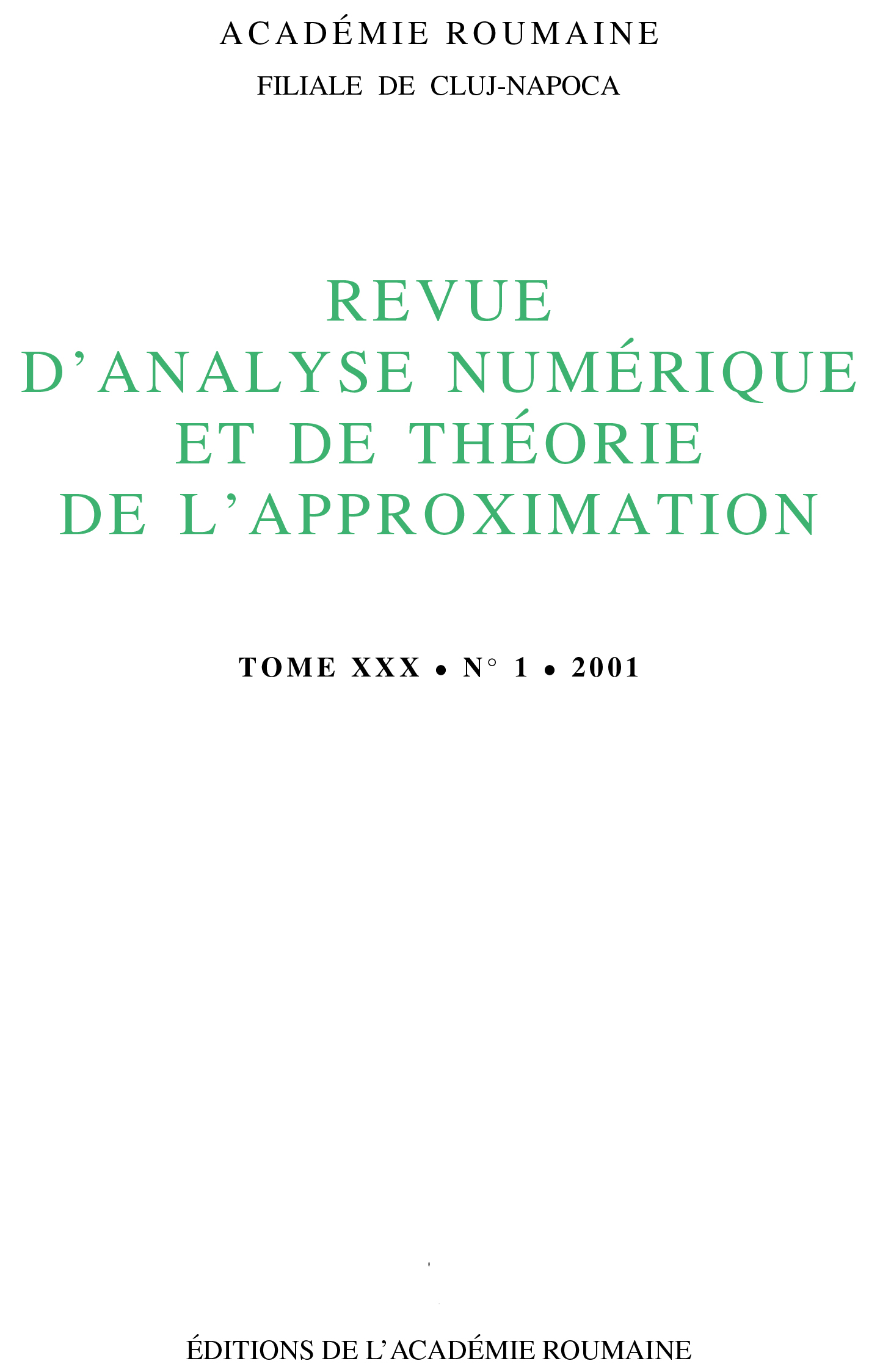On accelerating the convergence of the successive approximations method
DOI:
https://doi.org/10.33993/jnaat301-675Keywords:
successive approximations, inexact Newton methods, quadratic convergence, acceleration of the convergence of successive approximationsAbstract
In a previous paper of us, we have shown that no q-superlinear convergence to a fixed point \(x^\ast\) of a nonlinear mapping \(G\) may be attained by the successive approximations when \(G^\prime(x^\ast)\) has no eigenvalue equal to 0. However, high convergence orders may be attained if one considers perturbed successive approximations.
We characterize the correction terms which must be added at each step in order to obtain convergence with q-order 2 of the resulted iterates.
Downloads
References
I. Argyros, F. Szidarovszky, The Theory and Applications of Iteration Methods, CRC Press, Boca Raton, 1993.
I. Argyros, On the convergence of the modified contractions, J. Comp. Appl. Math., 55 (1994), 183–189, https://doi.org/10.1016/0377-0427(94)90019-1 DOI: https://doi.org/10.1016/0377-0427(94)90019-1
E. Catinas, Newton and Newton-Krylov methods for solving nonlinear systems in Rn, PhD Thesis, Babes-Bolyai University of Cluj-Napoca, Cluj-Napoca, Romania, 1999.
E. Catinas, On the high convergence orders of the Newton-GMBACK methods, Rev. Anal. Numer. Theor. Approx., 28 (1999) no. 2, 125-132.
E. Catinas, A note on the quadratic convergence of the inexact Newton methods, Rev. Anal. Numer. Theor. Approx. 29 (2000) no. 2, 129-133.
E. Catinas, Inexact perturbed Newton methods and applications to a class of Krylov solvers, J. Optim. Theory Appl., 108 (2001) no. 3, 543-570, https://doi.org/10.1023/a:1017583307974 DOI: https://doi.org/10.1023/A:1017583307974
E. Catinas, The inexact, inexact perturbed and quasi-Newton methods are equivalent models, submitted.
E. Catinas, On the superlinear convergence of the successive approximations method, submitted.
R.S. Dembo, S.C. Eisenstat, T. Steihaug, Inexact Newton methods, SIAM J. Numer. Anal., 19 (1982), 400-408, https://doi.org/10.1137/0719025 DOI: https://doi.org/10.1137/0719025
J.E. Dennis, Jr., J. J. More, A characterization of superlinear convergence and its application to quasi-Newton methods, Math. Comp., 28 (1974), 549-560, https://doi.org/10.1090/s0025-5718-1974-0343581-1 DOI: https://doi.org/10.1090/S0025-5718-1974-0343581-1
J.E. Dennis, Jr., R.B. Schnabel, Numerical Methods for Unconstrained Optimization and Nonlinear Equations, Prentice-Hall Series in Computational Mathematics, Engle-wood Cliffs, 1983.
P. Deuflhard, F. A. Potra, Asymptotic mesh independence of Newton-Galerkin methods via a refined Mysovskii theorem, SIAM J. Numer. Anal.,29 (1992), 1395-1412, https://doi.org/10.1137/0729080 DOI: https://doi.org/10.1137/0729080
S.C. Eisenstat, H.F. Walker, Choosing the forcing terms in an inexact Newton method, SIAM J. Sci. Comput.,17(1996), 16-32, https://doi.org/10.1137/0917003 DOI: https://doi.org/10.1137/0917003
Emil Catinas, N.J. Higham, Accuracy and Stability of Numerical Algorithms, SIAM, Philadelphia,1996.
V.I. Istratescu, Introduction to the Fixed Points Theory, Editura Academiei RSR, Bucharest, Romania, 1973 (in Romanian).
C.T. Kelley, Iterative Methods for Linear and Nonlinear Equations, SIAM, Philadelphia, Pennsylvania, 1995, https://doi.org/10.1137/1.9781611970944 DOI: https://doi.org/10.1137/1.9781611970944
St. Maruster, Quasi-nonexpansivity and two classical methods for solving nonlinear equations, Proc. AMS, 62 (1977), 119-123, https://doi.org/10.1090/s0002-9939-1977-0455354-4 DOI: https://doi.org/10.1090/S0002-9939-1977-0455354-4
St. Maruser, Numerical Methods for Solving Nonlinear Equations, Editura Tehnica, Bucharest, Romania, 1981 (in Romanian).
J.M. Ortega, W.C. Rheinboldt, Iterative Solution of Nonlinear Equations in Several Variables, Academic Press, New York, New York, 1970.
A.M. Ostrowski, Solution of Equations and Systems of Equations, Academic Press, New York, 1966.
I.Pavaloiu, Introduction to the Theory of Approximating the Solutions of Equations, Editura Dacia, Cluj-Napoca, Romania, 1976 (in Romanian).
F.A. Potra, V. Ptak, Nondiscrete Induction and Iterative Processes, Pitman, London, 1984.
F.A. Potra, On Q-order and R-order of convergence, J. Optim. Theory Appl., 63 (1989), 415–431, https://doi.org/10.1007/bf00939805 DOI: https://doi.org/10.1007/BF00939805
F.A. Potra, Q-superlinear convergence of the iterates in primal-dual interior-point methods, Math. Progr.,https://doi.org/10.1007/s101070100230 DOI: https://doi.org/10.1007/s101070100230
W.C. Rheinboldt, Methods for Solving Systems of Nonlinear Equations, SIAM, Philadelphia, 1998, https://doi.org/10.1137/1.9781611970012 DOI: https://doi.org/10.1137/1.9781611970012
H.F. Walker, An approach to continuation using Krylov subspace methods, Computational Science in the 21st Century, M.-O. Bristeau, G. Etgen, W. Fitzgibbon, J. L. Lions, J. Periaux and M. F. Wheeler, editors, John Wiley and Sons, Ltd., 72-82, 1997
Downloads
Published
Issue
Section
License
Copyright (c) 2015 Journal of Numerical Analysis and Approximation Theory

This work is licensed under a Creative Commons Attribution 4.0 International License.
Open Access. This article is distributed under the terms of the Creative Commons Attribution 4.0 International License, which permits unrestricted use, distribution, and reproduction in any medium, provided you give appropriate credit to the original author(s) and the source, provide a link to the Creative Commons license, and indicate if changes were made.










